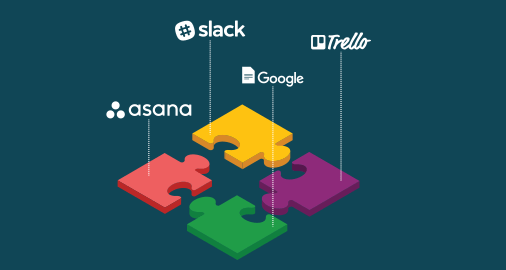15 collaboration tools for productive teams
Collaboration tools are software designed to help teams work together efficiently. They facilitate communication, project management, and collective creation, enhancing productivity. These tools can support remote work, streamline workflows, and foster creativity and innovation within teams.

On average, how many emails do you exchange with co-workers everyday? And how much time does it normally take to brief your team on goals or progress? If your answers make you cringe, you should consider updating your collaboration tools.
Team collaboration software is on the rise. From communication to project management, technology offers an abundance of options. More online collaboration tools spring up every year, while existing ones are constantly improving their features and functionality. Some companies grow and thrive through holacracy, a collaborative management structure.
Here’s a list of 15 of the best collaboration tools that can support your team’s needs:
Contents
Communicate with your team
People can’t collaborate if they don’t communicate. From instant messaging to video conferencing tools (the best alternative to face-to-face meetings), there are many options for team collaboration tools:
1. Flowdock
Flowdock is a group and private chat platform. Its most interesting feature is its team inbox which aggregates notifications from other channels, like Twitter, Asana and customer support tools.
2. GoToMeeting
GoToMeeting is an online video conferencing software that allows users to schedule meetings and share screens. It’s one of the most popular video tools with millions of users.
3. Slack
Slack is a popular and well-crafted platform offering instant messaging, file transfers and powerful message search. It has many features and dozens of integrations with other tools like Trello and Intercom.
4. WebEx
Cisco’s WebEx provides personalized video meeting rooms where users can to host and join meetings. People can use WebEx for team collaboration, webinars, training and customer support.
Manage projects and tasks
Project management tools are critical. Who can coordinate effectively when they can’t monitor task progress or keep track of objectives?
5. Asana
One of the most well-known project management tools, Asana allows users to assign tasks to other members, add followers to projects and monitor deadlines. It’s very useful as a to-do list or calendar for strategic planning.
6. Dapulse
Dapulse is a collaboration tool that helps you communicate, set objectives and assign tasks. Its big advantage: it has a great visual design so it’s easy to understand and work with.
7. ProofHub
ProofHub is a work management tool that offers a comprehensive suite of collaboration and project management functions. On this platform, you can organize files, plan and monitor projects and discuss with colleagues and stakeholders. ProofHub also lets you review and approve files through an online proofing tool.
8. Redbooth
Redbooth is an easy-to-use project management tool. Its platform allows users to plan and collaborate through many functions from video conferencing to creating Gantt charts.
9. Trello
Trello has an intriguing interface that resembles solitaire (you can even drag task cards across columns, just like you would playing cards). It’s easy to learn and works well for monitoring projects and assigning tasks. Trello also makes using Agile, Scrum and other project management frameworks easy.
10. Wimi
Wimi offers users their own ‘unified workspaces’ where teams can manage projects and share files and calendars. You can control access in each workspace with a rights-based system. Wimi Drive, their file syncing software, helps you make the most out of cloud technology.
11. Milanote
Milanote is one of the qualified tools that can be used for serving numerous purposes including blogging. Using this tool, you can organize creative projects and place them into excellent visual boards. It will provide you a feel like you’re working on the wall in a creative studio. Milanote would be a great fit too for designers who work remotely.
Related: Recruiting tools and techniques for modern HR teams
Creating together
A task isn’t always one person’s responsibility. Sometimes team members need to create together. These are the best collaboration tools:
12. Codingteam
Coders can easily collaborate when writing their code through platforms like Codingteam. It offers a free ‘software forge’ that encourages visibility and collective code building.
13. Igloo
Igloo is a company intranet that allows people to communicate and get work done. Its wiki allows colleagues to share information and ideas.
14. Google Docs
Google needs no introduction. Google’s collaboration tools include its Docs and Sheets services, which are designed to allow teams to edit files at the same time and save all their changes automatically.
15. Quip
Quip started off as a mobile app and released a desktop version later. Teams can import and work live on different file types. Edits are saved automatically and its chat, comment and checklist features make collaboration easy.
How do I choose the best collaboration tools for my business?
Companies should choose software that meets their individual needs. Here are some criteria that you can use to identify the best service for your team:
Prefer multiple features
Some tools offer excellent service but are only focused on one aspect of team collaboration. Give some thought to how efficient this really is. Teams may end up spending time changing between complementary software. It’s better to look for a tool that’s feature-rich and allows people to use it in many different ways.
Look for ease of use
This is obviously one of the most important criteria. If a service works but takes a lot of time to get used to, it won’t help teams (especially fast-growing teams.) Request a demo and keep an eye out for an intuitive interface and simple navigation.
Pay attention to privacy options
Collaborating with teams doesn’t mean all conversations and files should be public. Sometimes, you’ll want team members to have private conversations or work on sensitive projects. Make sure you look at privacy options before you choose a service.
Opt for cloud
Cloud-based technology has many advantages. It can solve your version control headaches by allowing you to see recent edits and activity. All information is stored online so everyone can be on the same page, no matter where they are.
Ask for integrations and compatibility
Remember that it’s better to use a tool with multiple features? Well, not always. Occasionally, you discover a tool that does one thing perfectly. Integrations are key. Look for tools that seamlessly integrate with other apps or software. Compatibility is also important. For example, your tools should support all the file types your team normally uses.
Tutorial: 17 effective candidate sourcing tools
Frequently asked questions
- How do businesses use collaboration tools?
- Collaboration tools are leveraged by businesses to enable teams to work together on projects, even when they're not in the same location. They enhance communication and project organization, thereby increasing workflow efficiency, especially in remote or distributed teams.
- What are the benefits of using collaboration tools?
- Collaboration tools significantly boost productivity by saving time and resources. They improve communication, foster idea generation, and enhance team morale. These tools also support remote work, making it easier for teams to collaborate effectively from different locations.
- Can collaboration tools help companies grow?
- Absolutely! Collaboration tools not only enhance team productivity but also foster creative problem-solving and idea generation. This can incite new ideas and innovative approaches, providing ample room for growth and evolution in the workplace.
- What should one consider when choosing collaboration tools?
- When choosing collaboration tools, it's important to consider multiple features, ease of use, privacy options, and whether the tool is cloud-based. Also, check for integrations with other apps or software and compatibility with the file types your team commonly uses.
- Can collaboration tools improve remote work?
- Yes, collaboration tools are essential for effective remote work. They facilitate seamless communication, efficient project management, and easy file sharing across different locations, making remote work more productive and less challenging.




